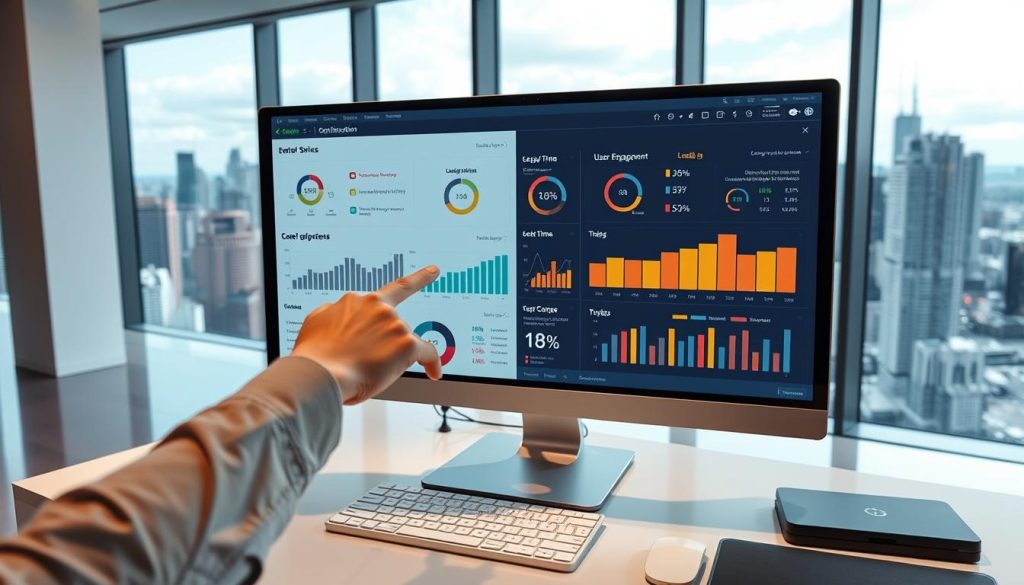Did you know 70% of websites have technical problems? These issues can hurt their search engine rankings. A technical SEO audit is key for website owners. It helps find and fix problems that affect your site’s search engine performance.
By doing a website SEO audit, you can boost your site’s ranking and visibility. A technical SEO audit checklist is vital. It makes sure your site is easy for search engines to find and use.
Doing a technical SEO audit is a detailed task. It checks your site’s crawlability, indexation, architecture, and speed. With a good SEO audit checklist, your site will be better for search engines and users. This leads to more visibility and better rankings through effective technical SEO.
Understanding the Importance of Technical SEO Audits
A technical SEO audit is key to boosting a website’s online presence. It checks a website’s technical parts, like its structure and how it works. This helps find areas to improve, like page speed and mobile use.
By doing a technical SEO audit, site owners learn what’s good and bad about their site. This lets them make smart choices to improve their online presence.
A detailed technical SEO audit looks at a website’s technical performance. It finds ways to make the site better. This is important for making the site more visible and user-friendly.
By fixing technical issues, site owners can get better search rankings. This brings more visitors and boosts sales.
Things like page speed and mobile use are vital for a good user experience. A technical SEO audit finds ways to improve these areas. This makes the site better for everyone.
By focusing on technical SEO audits, site owners can stay ahead. They can reach their online goals faster.
Essential Tools for Your Technical SEO Audit
For a technical SEO audit, the right tools are key. On-page seo tools like Google Search Console spot technical issues. Off-page seo tools, such as Ahrefs and SEMrush, check your backlinks and rankings.
Reviewing your website’s performance is also vital. This means checking speed, mobile friendliness, and user experience. Google PageSpeed Insights can help find and fix these issues.
These tools offer deep insights into your website’s performance. They help you make smart choices to boost your site. Whether it’s for better rankings or a better user experience, the right tools are essential.

Using on-page and off-page seo strategies can greatly improve your site. A detailed performance review can highlight areas for betterment. This way, you can optimize your site for better results.
Crawlability and Indexation Assessment
To make sure your website shows up in search engines, you need to check crawlability and indexation. This means looking at how search engines find and list your site’s content. By following good SEO practices, you can find and fix problems that stop your site from being seen.
A technical SEO audit is key to finding what needs work. It looks at crawlability and indexation closely. This includes setting up robots.txt, checking XML sitemaps, and seeing how well your site is indexed. This makes sure your site’s content can be found and listed, which is important for getting more visitors.
Using these methods can help your site show up more in search engines and get more visitors. Always follow SEO best practices and do regular technical SEO audits. This keeps you ahead of others and helps you reach your online goals.
Website Architecture and URL Structure
A well-organized website is key for technical seo. It helps search engines understand your site better. This can boost your search rankings and make your site easier to use.
Using on-page seo, like optimizing your site’s structure, can make a big difference. Techniques like url rewriting help create clear, easy-to-read urls. These are good for both users and search engines.
Technical seo audits often find problems with your site’s structure and urls. A complex site can make urls hard for search engines to follow. This can cause indexing issues.
By making your site’s structure simpler and urls more straightforward, you can help search engines crawl and index your site better. This can lead to higher rankings and more visibility online.

A well-organized site also makes it easier for users to find what they need. When users can easily navigate and find information, they’re more likely to stay and engage. This can lead to more conversions and better site performance.
By focusing on website optimization and on-page seo, you can make your site friendly to both search engines and users.
Conducting a Complete Technical SEO Audit Step-by-Step
To do a thorough technical SEO audit, follow a clear plan. Start with an initial site analysis to see how your website is doing. Look at crawlability, indexation, and performance. A checklist for website SEO audits helps make sure you don’t miss anything important.
In the initial site analysis, you’ll look at your website’s structure, content, and tech setup. This helps you find what needs work and shapes your audit plan. You might use log files, crawling tools, and website architecture reviews. Keeping track of your findings and making a checklist helps you focus on the most important issues.

As you move on in the audit, sort issues by how bad they are and their impact. Look at page speed, mobile friendliness, and content quality. A clear plan and a checklist make your audit detailed and effective. This boosts your website’s visibility and search rankings.
Mobile Optimization and Responsiveness
Most website visitors use mobile devices. So, making your site mobile-friendly is key for a great user experience. It also helps your site rank better in search engines. This means your site should work well on all devices, not just desktops.
Having a mobile-first indexing checklist is important. It ensures your site loads fast and is easy to use on phones. Slow sites can make people leave quickly, hurting your rankings.
Mobile-First Indexing Checklist
Here’s what your mobile-first checklist should cover:
- The site should work well on all screen sizes.
- It should load quickly for a better user experience.
- Navigating the site on phones should be simple.
Speed Optimization for Mobile Devices
To speed up your site on phones, try a few things. Compress images and minify code. Also, use caching to make things faster. These steps can make your site more user-friendly and boost conversions.
Mobile UX Assessment
Assessing your site’s mobile UX means checking how it works on phones. Look at navigation, content, and overall ease of use. This helps you find and fix problems, making your site better for mobile users.
Site Speed and Performance Metrics
Checking a website’s speed and performance is key. It helps find ways to make a site faster and better. By following SEO best practices, sites can get better rankings and user satisfaction.
Site speed is very important for SEO. It affects how users feel and how search engines rank a site. Using tricks like code minification and image compression can make a site faster. Regular checks and audits help keep a site running smoothly.
Using SEO best practices can really help a site’s speed. For example, making images smaller and coding more efficiently can make a big difference. By focusing on speed, sites can offer a better experience for everyone.

Security and SSL Implementation
Security is key in technical SEO. It affects user trust and search engine rankings. SSL certificates are vital for protecting user data and ensuring a secure experience.
A good seo analysis can spot security risks. It offers tips to make your site safer.
HTTPS configuration is a big part of security. It makes sure all website traffic is encrypted. This stops hackers from getting user data.
Checking security headers is also important. It finds weak spots and suggests fixes. This keeps your site safe from attacks.
Mixed content issues are a big security risk. They happen when a site uses both HTTP and HTTPS content. A detailed seo analysis can find and fix these problems.
By focusing on security and SSL, you protect user data. You also boost your site’s search engine ranking. This improves your site’s overall performance.
Content Optimization and Structure
Content optimization is key for on-page seo. It affects how users feel and how search engines rank your site. A technical seo audit helps find and fix issues. This makes your content better and meets your audience’s needs.
A good website structure is vital for optimization. It helps search engines find and list your content well. This boosts your site’s visibility and ranking on search engines.
To make your content better, use keyword research and content marketing. Create content that is both useful and interesting. This way, you can draw in and keep the right audience. It also brings more visitors and sales to your site.
Getting a technical seo audit is important. It shows you how to make your site better. By focusing on content and structure, you can get more people to visit your site. This helps you reach your online goals.
Technical On-Page Elements Review
Technical seo is key for search engines to understand website content. A good website seo audit checklist checks these elements. This includes meta tags, header tags, and schema markup.
Meta tags give search engines important info about a webpage. This includes the title tag, meta description, and keyword tag. It’s important to fill these tags out right and match them to the content.
Header tags help organize content and point out important points. A clear header tag hierarchy helps search engines and users. Schema markup adds extra context, like reviews and ratings.
Using these technical on-page elements in a website seo audit boosts online presence. It drives more traffic and increases conversions. A detailed technical seo audit checklist shows how to improve on-page elements for better rankings.
Conclusion: Implementing Your Technical SEO Audit Findings
Now that you’ve done a detailed technical SEO audit, it’s time to act on what you found. The best way to improve your website is to follow the audit’s advice. Start with the most important changes that will help your site rank better and feel better to users.
Focus on making your site easier for search engines to find and faster to load. Also, make sure it works well on mobile devices. Begin with the easy fixes, then tackle the harder tasks like adding structured data and improving your content’s organization.
Technical SEO is not a one-time job. It’s something you need to keep up with. Keep an eye on how your site is doing, learn from new data, and keep making changes. By being active and using what you learned, you’ll get more visitors and make your site better for everyone.



